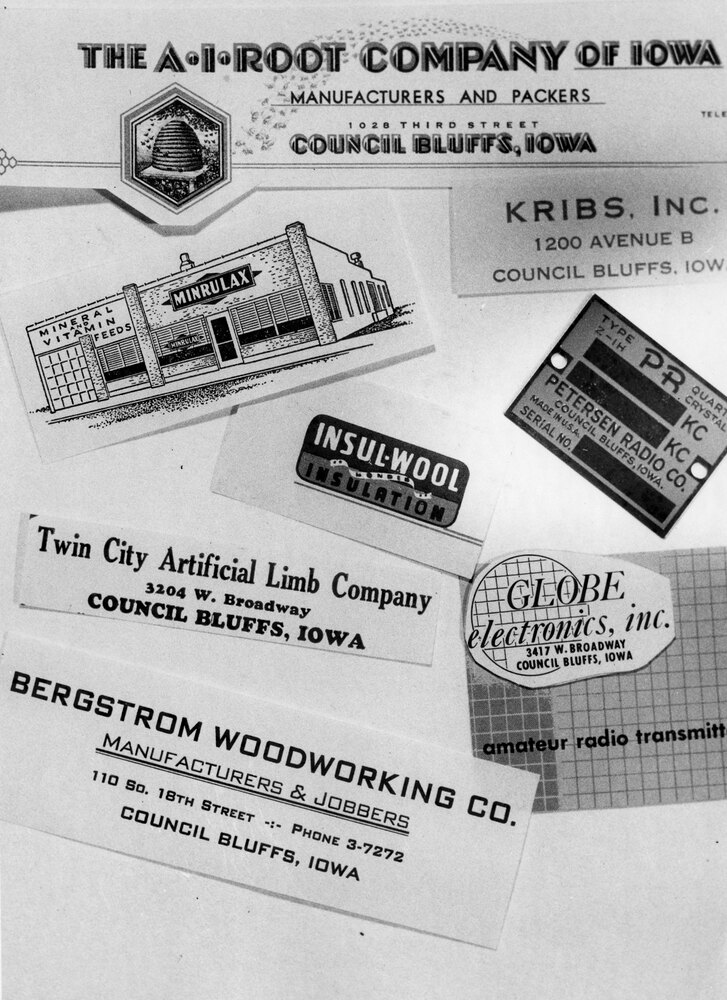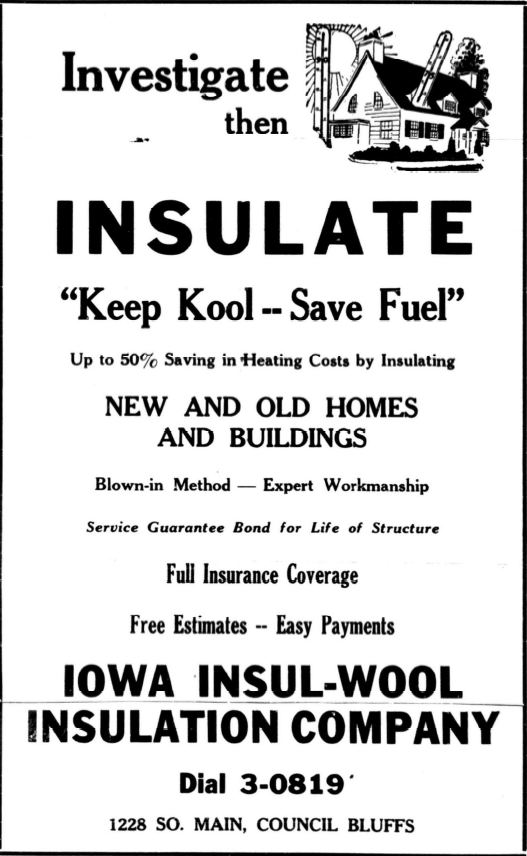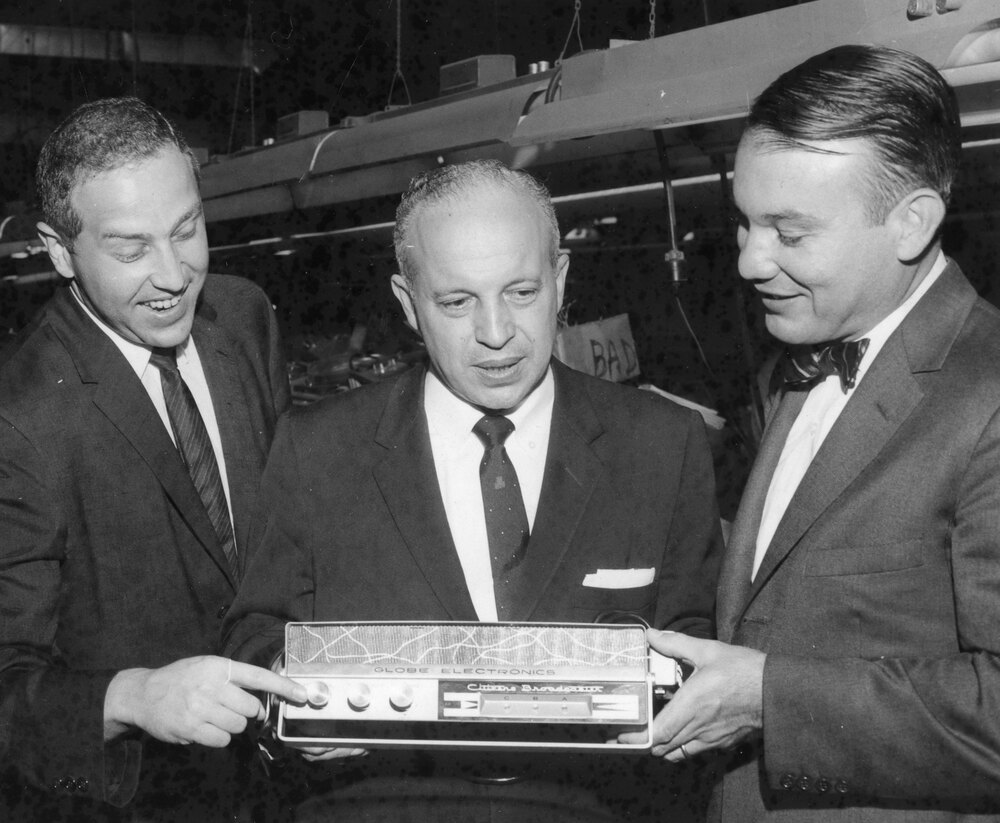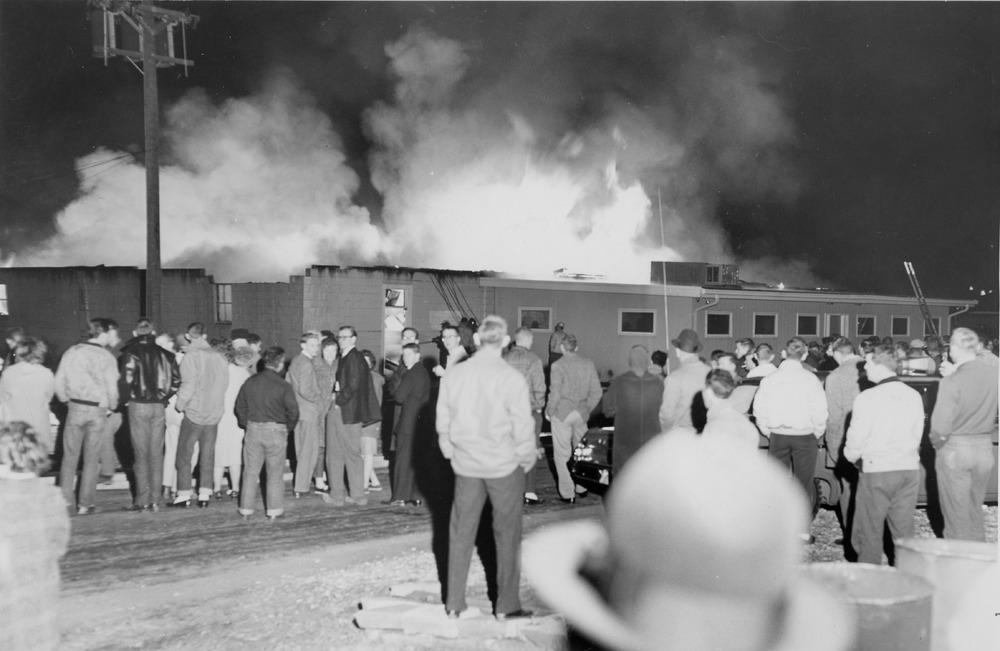
This is part three of a series focused on various company logos found in the August 21, 1958 issue of the Daily Nonpareil. A brief history of each business is included. The text from the original article read:
"Quiz a man about his home town, and he will surprise you with how little he knows-even of its most important assets. To any community a basic asset is its industry-the plants which provide paychecks for many of its citizens. And its products going out across the nation and the world are a city's most important ambassadors. Why do you know about Council Bluffs industry? The 37 insignia on this page represent a big share of the variety of products which might bear the label: 'Made in Council Bluffs.' How many do you recognize?"

The A. I. Root Company was founded in Medina, Ohio by Amos Ives Root in 1869. The company focused on beekeeping supplies and developed equipment that allowed for the mass production of honey. A Council Bluffs location was opened in 1919 at 1028 3rd Street. The company maintained an annual catalog that customers ordered from but also sold products through retailers as well. In addition to beekeeping supplies, the company also raised bees and sold honey. In the early 1930s, the company began using excess beeswax to manufacture candles used in churches. The process involved hand-wrapping sheets of beeswax around wicks. The candles started to steadily outsell the beekeeping supplies sold by the company. In the 1970s, the A. I. Root Company built a new facility at the same location and started to expand its operations to include decorative candles that were colored and scented. Despite substantial increases in the sales of scented candles, the Council Bluffs location stopped producing candles in 1988. The company decided it would be more economical to manufacture everything at their main Ohio manufacturing plant. The Council Bluffs facility became a distribution center and featured a retail warehouse until it was closed in the mid 1990s. A. I. Root Company (now known as Root Candles) is still around today.
Kribs, Inc. was formed in 1958 by Edward and Jane Evans, Richard and Dolores Borman, and Ralph Jansen. According to a Daily Nonpareil article from April 28, 1958, “the firm is to manufacture and sell at retail and wholesale personal property of all kinds for agricultural, industrial, and commercial uses.” The business was located at 1200 Avenue B and one of its first jobs reported in the Daily Nonpareil was producing snow fences. The company did not exist for very long as Edward Evans was later listed as the president of Crawford Lumber Company in February of 1959.
Minrulax, Inc. was founded in the mid 1930s by Henry H. Hand and was located at 1102 South Main Street. The company sold feeds, minerals, vitamins, antibiotics, and pre-mixes for livestock to farmers in Iowa, Nebraska, Illinois, and Minnesota. In the early 1950s, the company moved to a new location at 1800 West Broadway. Henry Hand passed away in 1958 and leadership of the company was given to his son, Robert D. Hand. The company held annual meetings in Council Bluffs for its Midwest salesmen to discuss sales figures for the previous year and recognize employees for their achievements. In the mid 1970s, Howard W. Beaman became president and the company continued to operate in Council Bluffs until 1987, when it was no longer listed in the Council Bluffs city directory.
Insul-Wool Insulation Company was a Kansas-based corporation that had various locations across the country including one in Iowa. The Iowa facility was started in Shenandoah in 1938 by A. C. Kruse. According to a Daily Nonpareil article from October 31, 1946, Kruse “operates under franchise on patents of the Wichita firm, but is privately owned and operated.” The Insul-Wool Insulation Company moved to Council Bluffs in 1945 and occupied 1228-1230 South Main Street. In an interview with the Daily Nonpareil in March of 1945, Kruse talked about the manufacturing process for the insulation. Waste paper from magazines and newspapers was shredded in a milling machine to create wood fibers. Then, the “wood fibers are ground into tiny flakes, then chemically treated to resist fire, moisture, and vermin. The flakes are then blown into the areas to be insulated.” The company used a fleet of “nine specially equipped blower trucks” to install the insulation through a pressurized system. Insul-Wool Insulation Company products were used in residential buildings, commercial buildings, cold storage, deep freeze cabinets, and frozen food lockers. In 1959, Insul-Wool Insulation was purchased by Orville Fancher, owner and operator of Fancher Electrical Contracting Company. The company was renamed to Fancher Electric and Insulation Company and continued its operations out of the 1228 South Main Street building until about 1965. After this point, Orville Fancher ran the business out of his house at 3426 3rd Avenue until his death in 1980.

Petersen Radio Company, Inc. was started by an amateur radio enthusiast named William Petersen. The company produced specialized quartz crystals designed to control frequency in radio equipment. A Daily Nonpareil article from July 20, 1937 detailed Petersen’s process of refining the quartz crystals and he explained that producing the crystals started off as a hobby. He received his amateur radio operator’s license in 1930 and decided to try making the crystals himself to reduce costs. Through trial and error, William was able to produce working crystals for his own equipment and soon found demand for his product from other radio enthusiasts. By 1936, the demand was so great, Petersen was able to quit his full time job and focus on manufacturing quartz crystals at a small factory he opened at 2800 Broadway. During World War II, Petersen Radio Co. manufactured crystals for military equipment. Due to the demand, the company operated 24 hours a day, seven days a week for a period of “four years and ten months.” Petersen Radio Co. normally employed 25 people but during their peak operations for the war effort, they employed 176. In 1946, Petersen Radio Company was incorporated with William as president and his wife Dorris as the secretary-treasurer. William Petersen passed away in 1963 and the company continued under Dorris and son, William, until the early 2000s.
Twin City Artificial Limb Company was formed in 1910 by owner and operator John F. Johnson. It focused on manufacturing artificial arms and legs, with a large portion of their business coming from soldiers who were wounded in battle. According to a March 9, 1919 Daily Nonpareil article, soldiers were “taken to [Johnson’s] home, which adjoins the factory and kept here while their limbs are made and while they are learning to use them.” The whole process took about two weeks to complete. Originally located at 406 West Broadway, the company was one of two artificial limb companies in Iowa in the 1910s. The business soon moved to 541 West Broadway in 1913, 14 North Main Street in 1916, 3025 West Broadway in 1919 and then to 3029 West Broadway in 1930. In 1935, John F. Johnson passed away and the business went to his wife, Blanche Johnson. The business was operated under her ownership until about 1940 when the business was sold to Edward V. Lucas, an employee of the company and a former client. An April 17, 1955 Daily Nonpareil article states that “Lucas himself lost both legs in World War I. He went to work for the man who made him artificial ones in 1919.” Lucas moved the business to 3204 West Broadway and World War II brought an increased demand for artificial limbs. Lucas explained that “in pre-war years, the biggest class of business came as a result of farm accidents. Railroad accidents were in a minority; but a high percentage of customers are diabetic.” Lucas passed away in 1967 and the business was then purchased by David S. Burton and Frank Sima Jr. Twin City Artificial Limb Company operated until around 1974. After this point, the business was no longer listed in the city directories.
Globe Electronics, Inc. was the manufacturing division of World Radio Laboratories. Founded in 1935 by Leo Meyerson, World Radio Laboratories was instrumental during World War II in the effort to mass produce quartz crystals used to control radio frequencies in military equipment. Following World War II, the company continued to produce a range of radio equipment and electronics, particularly for ham radios. It was also involved in the production of consumer electronics in the 1960s. A separate production division of World Radio Laboratories was founded in the early 1950s. Originally named WRL Electronics, it was located in the same building as the parent company at 3415 West Broadway. The name was changed to Globe Electronics in 1958. The company was bought by Textron Electronics of Providence Rhode Island in 1959. The purchase allowed the company to double their floor space dedicated to production. Globe sold various ham radio models but their most popular versions were the Globe Scout and the Globe King. They also produced other electronic devices including pocket-size two-way radios. According to the March 3, 1960 issue of the Daily Nonpareil, “‘Pocketphones’, as they are termed, are a little bigger [and are] specifically designed as handy paging units.” In 1961, Globe Electronics, Inc. was moved to Rockford, Illinois because the parent company, Textron, wanted to consolidate its operations. The company was merged with GC Electronics, another Textron subsidiary, around this time and the company still exists today. World Radio Laboratories was sold by the Meyerson family in 1988 to Luke T. Northwall and Malcolm Ballinger and declared bankruptcy in 1989. It continued to operate at its Council Bluffs location until 1990. A Daily Nonpareil article from April 22, 1990 reported that owner Malcolm Ballinger planned to move the company to Omaha around June of 1990 but this did not appear to materialize.

Bergstrom Woodworking Company was started in 1948 by Donald Bergstrom. The company primarily manufactured wooden frames for furniture and sold them to local upholsterers. They frequently made davenports, chairs, and platform rockers but also branched out to picnic tables, restaurant booths, and special order doors and window moulding. It was originally located at 110 South 28th Street. This building was later sold to the Iowa Soda Products Company around 1955 and Bergstrom Woodworking Company moved to a new facility at 110 South 18th Street. On November 26, 1962, a fire broke out at the facility and Donald Bergstrom declared the building a “total loss” according to a Daily Nonpareil article from November 28, 1962. While the business was closed, some employees were transferred to Bergstrom’s brother’s business, Wood Products, while others were assigned to clean up the property and salvage what was left. Nearly one year later, Bergstrom Woodworking rebuilt their facility and reopened at the same location. In 1965, the company decided to start a second business called BW Chair Company. It was located in the same building as the original business. The focus was to manufacture office chairs to customer’s specifications. This required adding an upholstery department to the building. By 1968, both Bergstrom Woodworking Company and BW Chair Company were no longer listed in the city directory and the building at 110 South 18th Street was occupied by Iowa Rigger’s Loft.

Click HERE for more information on Council Bluffs History.
Sources:
Various Daily Nonpareil articles
Historical Society of Pottawattamie County newsletter (Fall 2016)
Root Candles company information
"Whatever happened to Globe?" archived blog post from WorldRadioLabs.com